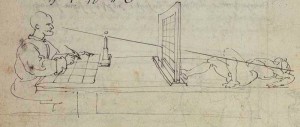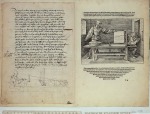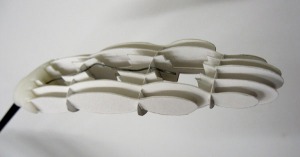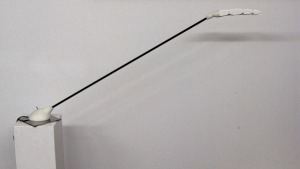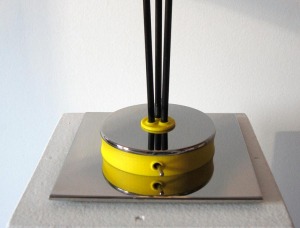While researching into the perspective relationship between the picture elements of this print (see earlier posts in English and in Deutsch) I noticed several ‘abnormalities’ in reproductions of this so well known work by Duerer. These abnormalities appear on paper representations and on digital images of this print. This post is to bring together these titbits.
In 2006 I was privileged to see originals of Dürer’s ‘The Painters Manual’, these splendid copies of this renaissance publications are held at the National Gallery of Victoria (NGV) in Melbourne, Australia. The ‘Man drawing a lute’ image is towards the back of these publication and is relatively small in size, 182 x 132 mm, rather like a postcard, the detail and the precisions of the lines however are impressive. The NGV, which very generously opened its archives for me, holds a large if not the largest collection of Albrecht Dürer’s graphic and print work outside Germany.

Now to the abnormalities in the reproductions:
1.) The vertical ‘rift’ in the upper middle of the print.
The following image shows in its upper part the print as in the original publications, while the image in the lower part shows it with the ‘rift’.

I found this distortion not present in the 1525 or the 1538 (NGV, Melbourne) editions but in many reproduction of images on the internet and in the following books, some declare to show ‘facsimile’ of Dürer’s print works.
Dürer today, pge 48
1970 and 1978 by Heinz Moos Verlag, Munich, ISBN 3-7879-0119-1
The Complete Woodcuts of Albrecht Dürer, illustration 338, Edited by Dr. Willi Kurth
1963, Dover Publication, New York, ISBN 0-486-21097-9
Albrecht Dürer, Les Gravures sur Bois
1978, Art et Culture, Paris, No d’impression: 5799
Initially I believed it to be a clue to help prove that Dürer (or the woodcutter) had made a mistake or change to the original print leading to the wrong relation of the perspective elements as discussed in earlier posts on this blog (see earlier posts in English and in Deutsch). But as I had to discover, while inspecting the almost 500 year old originals at the NGV, this distortion is not visible in the original editions. It seems to be an artefact from a later printing process of copies. The paper might have been ‘pinched’ at an early print run and subsequent copies and facsimiles have just helped reproducing this fault.
2.) The change in the quality of line.
Close inspection of the originals also showed a visible change in the quality of the line delineating the white space on the table below the open frame with the point drawing of the lute. This change is visible in all reproductions of this print. The weight or thickness changes at this location, some seem to run together with their neighboring line just as if they have been corrected or added later. And to support my theory (see earlier posts in English and in Deutsch), these ‘abnormal’ lines start where I suspect the frame should be placed in the composition of the print to make the perspective alignment of all elements right. Here is a crop of the highest resolution image I was able to find, which shows the changes in lines clearly.

I found this image on ArtStore.
3.) ‘Pirate’ copy of this print

On ArtStore there are several digital images of Dürer’s ‘Man drawing a Lute’ print, one of them looks like it had been printed from a re cut woodblock. It shows ‘1530’ as date, two years after Dürer’s death !– the original had 1525 as date – and a sanitised point-drawing of the lute. Duerer’s work, very popular during his life time achieved respectable retail prices leading to illicit copies.
Finally, I found a little reference about a handwritten note by Dürer on the back of the 1st edition in Nuernberg on the back of this print. I love to know what he wrote, as it might shed some light on some of my questions I have about the composition of this work. This remark appears on page 266 in the 3rd of three volumes, this book focuses exclusively on Dürer’s book illustrations. These wonderful books, edited by Rainer Schoch, Matthias Mende and Anna Scherbaum, are the most comprehensive publications about Duerer’s print (Druckgraphische) work. I hope one day to be able to read Dürer’s note and to find out more about this significant print.
If you have any further information about this print by Dürer or any comment about my views of his work please get in touch.





